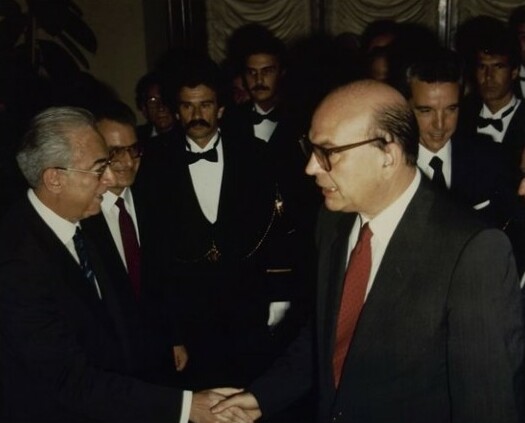1985 Italian Presidential Election on:
[Wikipedia]
[Google]
[Amazon]
The 1985 Italian presidential election was held on 24 June 1985.
Only members of

Parliament
In modern politics, and history, a parliament is a legislative body of government. Generally, a modern parliament has three functions: representing the electorate, making laws, and overseeing the government via hearings and inquiries. Th ...
and regional delegates were entitled to vote, most of these electors having been elected in the 1983 general election and in the 1985 regional elections. As head of state
A head of state (or chief of state) is the public persona who officially embodies a state Foakes, pp. 110–11 " he head of statebeing an embodiment of the State itself or representatitve of its international persona." in its unity and l ...
of the Italian Republic
Italy ( it, Italia ), officially the Italian Republic, ) or the Republic of Italy, is a country in Southern Europe. It is located in the middle of the Mediterranean Sea, and its territory largely coincides with the homonymous geographical re ...
, the President has a role of representation of national unity and guarantees that Italian politics
The politics of Italy are conducted through a parliamentary republic with a multi-party system. Italy has been a democratic republic since 2 June 1946, when the monarchy was abolished by popular referendum and a constituent assembly was electe ...
comply with the Italian Constitution
The Constitution of the Italian Republic ( it, Costituzione della Repubblica Italiana) was enacted by the Constituent Assembly on 22 December 1947, with 453 votes in favour and 62 against. The text, which has since been amended sixteen times, ...
, in the framework of a parliamentary system
A parliamentary system, or parliamentarian democracy, is a system of democratic governance of a state (or subordinate entity) where the executive derives its democratic legitimacy from its ability to command the support ("confidence") of th ...
.
As a result of the election, Francesco Cossiga was elected President on the first round with almost 75% of the votes. It was the first time in the history of the Italian Republic
Italy ( it, Italia ), officially the Italian Republic, ) or the Republic of Italy, is a country in Southern Europe. It is located in the middle of the Mediterranean Sea, and its territory largely coincides with the homonymous geographical re ...
that a President had been elected on the first round.
Procedure
In accordance with theItalian Constitution
The Constitution of the Italian Republic ( it, Costituzione della Repubblica Italiana) was enacted by the Constituent Assembly on 22 December 1947, with 453 votes in favour and 62 against. The text, which has since been amended sixteen times, ...
, the election was held in the form of a secret ballot, with the Senators and the Deputies entitled to vote. The election was held in the Palazzo Montecitorio
The Palazzo Montecitorio () is a palace in Rome and the seat of the Chamber of Deputies, the lower house of the Italian Parliament.
History
The palace's name derives from the slight hill on which it is built, which was claimed to be the ''Mon ...
, home of the Chamber of Deputies, with the capacity of the building expanded for the purpose. The first three ballots required a two-thirds majority of the 1,008 voters in order to elect a president, or 673 votes. Starting from the fourth ballot, an absolute majority was required for candidates to be elected, or 505 votes. The presidential mandate lasts seven years.
The election was presided over by the President of the Chamber of Deputies Nilde Iotti, who proceeded to the public counting of the votes, and by the President of the Senate Francesco Cossiga.
Candidates
Francesco Cossiga, former Prime Minister and Minister, member of the Christian Democracy's left-wing faction, was first proposed by the party's leader Ciriaco De Mita as the candidate of the governing ''Pentapartito
The Pentapartito (from Greek , "five", and Italian , "party"), commonly shortened to CAF (from the initials of Craxi, Andreotti and Forlani), refers to the coalition government of five Italian political parties that formed between June 1981 a ...
'' alliance.
Political background
In the 1980s, for the first time since 1945, two governments were led by non-christian democrat Prime Ministers: a republican ( Giovanni Spadolini) and a socialist (Bettino Craxi
Benedetto "Bettino" Craxi ( , , ; 24 February 1934 – 19 January 2000) was an Italian politician, leader of the Italian Socialist Party (PSI) from 1976 to 1993, and the 45th prime minister of Italy from 1983 to 1987. He was the first PSI membe ...
); while the Christian Democracy remained however the main force supporting the government.
With the end of the Years of Lead, Craxi cabinet was working to restore stability in the Italian politics. The candidacy of the christian democrat Francesco Cossiga, first proposed by the Christian Democracy leader Ciriaco De Mita, was sustained by all the parties which were members of the coalition government (the so called ''Pentapartito
The Pentapartito (from Greek , "five", and Italian , "party"), commonly shortened to CAF (from the initials of Craxi, Andreotti and Forlani), refers to the coalition government of five Italian political parties that formed between June 1981 a ...
'' alliance) and also by the communist leader Alessandro Natta
Alessandro Natta (7 January 1918 – 23 May 2001), was an Italian politician and secretary of the Italian Communist Party (PCI) from 1984 to 1988.
Before and during the World War
Born in Oneglia, Natta attended the Scuola Normale Superiore ...
.
On 24 June 1985 Cossiga was elected President and officially sworn in on 3 July 1985.
Results

Notes
References
{{Italian presidential elections Presidential elections in Italy 1985 elections in Italy